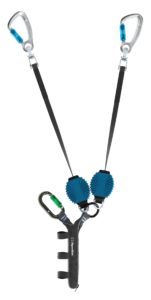SpanSet: The Needs and Challenges of Fall Arrest

When choosing fall protection measures Fall Arrest comes down at the bottom of the hierarchy, but is still the only option for many workers. Understanding why it is the last option in the hierarchy and what the real issues are helped SpanSet take on what we see as currently one of the most important challenges in work at Height.
Why is Fall Arrest chosen
 It is common for Workers at height to need the freedom to work or reach near an exposed edge and that freedom can bring with it the potential for a fall to occur. Restricting the freedom of movement with a Restraint system can prevent the fall. The problem is that restricting the freedom of movement can also restrict the ability to carry out the task thus defeating the object.
It is common for Workers at height to need the freedom to work or reach near an exposed edge and that freedom can bring with it the potential for a fall to occur. Restricting the freedom of movement with a Restraint system can prevent the fall. The problem is that restricting the freedom of movement can also restrict the ability to carry out the task thus defeating the object.
Fall arrest solutions can be quick to set up and so for short duration tasks the overall level of risk may be acceptable.
If developments introduce Fall Arrest systems that are better able to limit the risks and high quality training helps users to gain the benefits yet understand the consequences such as clearance heights or rescue implications then the justification will be easier.
The Two most common forms of Fall Arrest – Shock Absorbed Lanyards and Fall Arrest Blocks (or inertia reels).
Whilst these two options both aim to achieve the same goal of catching a falling worker, they traditionally did so in different ways. Recent developments are changing this and in future the distinctions will be less obvious. It is however worth understanding what happens during a fall and how the different approaches originated.
The fall of a user can be split into 2 stages – 1. The Free Fall stage (before the equipment becomes taught and while the falling user accelerates) and 2. the Arrest stage (Once the forces of the falling user are applied and the deceleration occurs). The longer the Free Fall Distance the more the user accelerates and so the more work there is to do during the arrest stage often increasing. During the arrest stage the device has to stop the user in a controlled manner dissipating excess energy if required.
Fall Factors are referred to by some, but misused by most. Fall Arrest equipment reacts to the actual distance the user has fallen irrespective of the lanyard or attachment length, so the Free Fall Distance is more useful in predicting outcomes.
Fall Arrest Lanyards complying to EN standards are available in lengths up to 2 metres and normally consist of a set length of webbing or rope incorporating a shock absorbing pack.
When attached to a suitable anchor the user can work anywhere within the range of the lanyard. When the anchor is the maximum distance below, the free fall will be at its longest and so the higher the anchor the shorter the free fall. In all cases the lanyard will not do anything for the user until it is under tension. The majority of lanyards sold are the maximum allowable length resulting in a potential free fall distance of up to 4 metres. Where the full length is not required any slack in the system simply increases the free fall distance unnecessarily.
During the Free Fall Distance the user will accelerate generating energy. Once the lanyard becomes taught the Arrest phase begins with the shock pack acting as a brake, reducing the excess energy and preventing the user from experiencing too high an impact force, but extending as it does so.
The main problem is that the longer the free fall distance the longer the shock pack will extend during braking. The result is a longer fall overall or a greater clearance required below the user to allow all this to happen.
Fall Arrest Blocks operate much like a car seat belt retractor paying out as required, but retracting when possible removing any slack from the system. Traditionally they were anchored above the user and so their ability to remove slack from the system meant that the free fall distance was simply the distance required by the device to lock up.
As the free fall distance is vastly reduced so is the energy created resulting in a significant reduction in the Arrest Distance, the combination of which is a much reduced Overall Fall Distance.
The two options have different benefits, but also different requirements needed to achieve them. Traditional lanyards are ideal where low level attachment is required, but suffer from the larger overall Fall Distance whilst Fall Arrest Blocks are ideal in low clearance areas due the smaller Overall Fall Distance, but need an overhead anchor to achieve it.
What if you have a small clearance height below you and no overhead anchorage?
 This is where the advances in Self Retracting Lanyards such as the DSL come in.
This is where the advances in Self Retracting Lanyards such as the DSL come in.
Like a traditional Fall arrest Lanyard it is available in a length up to 2 metres for freedom of movement, but instead of being static the lanyard legs retract eliminating any slack from the system and making them effectively the shortest length you can use at that time.
Should a fall occur the lanyard will be as short as possible to start with. If the anchor is above there will be no slack, but if the anchor is below the user it will retract further getting even shorter.
Once the device locks up the integral Shock Absorber can accommodate Free Fall Distances up to 4 metres just like a traditional Fall Arrest Lanyard, however with the retractors included the actual Free Fall Distances are far smaller.
The results of this are that the Free Fall Distance is minimised which in turn reduces the arrest distance and therefore the Overall Fall Distance is significantly lower.
The benefit to the user
The DSL changes the rules. It provides workers with a full length lanyard for when they need it, but is only as long as they need it at the time.
The obvious benefit to a user is that there is no slack lanyard to snag or create a trip hazard, but the more important benefit is what this lack of slack means –
- Effective Fall Arrest Protection in areas with reduced clearance heights
- Reduced Overall Fall Distances provide less opportunity for a falling user to collide with obstacles and structures
- Many falls will be so small that the user may not require rescue, but will simply be able to climb back to where they came from
How big are the benefits
In testing SpanSet have found that when using a DSL anchored 2 metres below the mass i.e the maximum permitted fall onto a Fall Arrest Lanyard that the mass has been arrested before a conventional lanyard would have even become taught.
In summary it is just like a car – if we can ensure the user is travelling slower when we apply the brakes, then they stop sooner and with the DSL we can.
